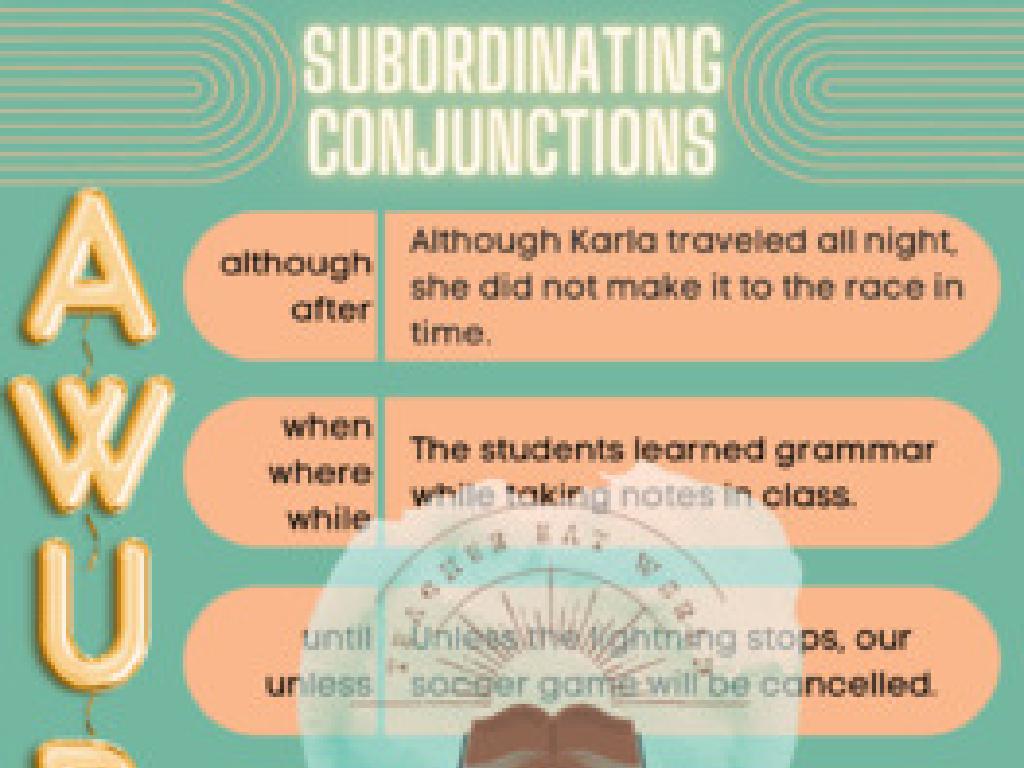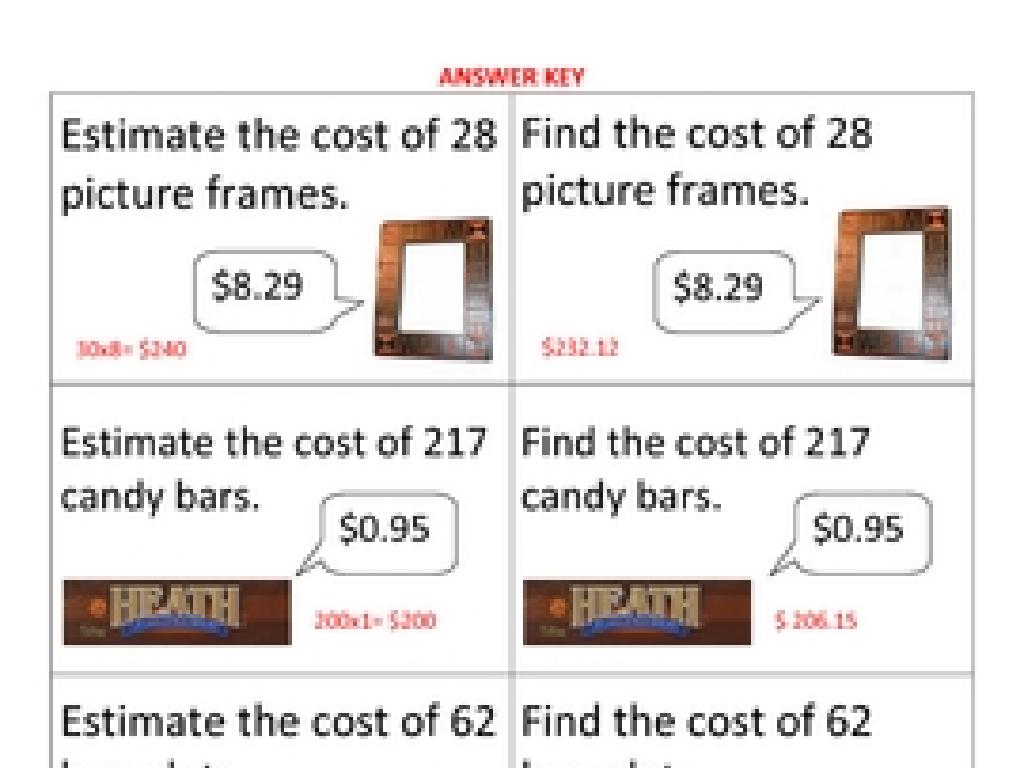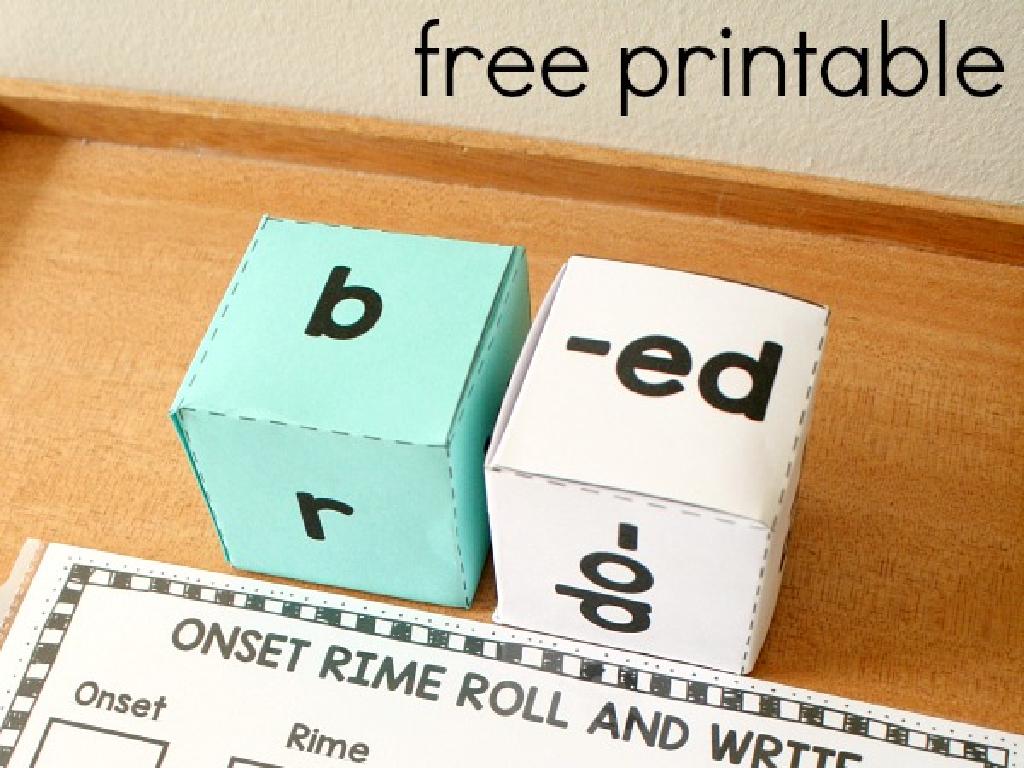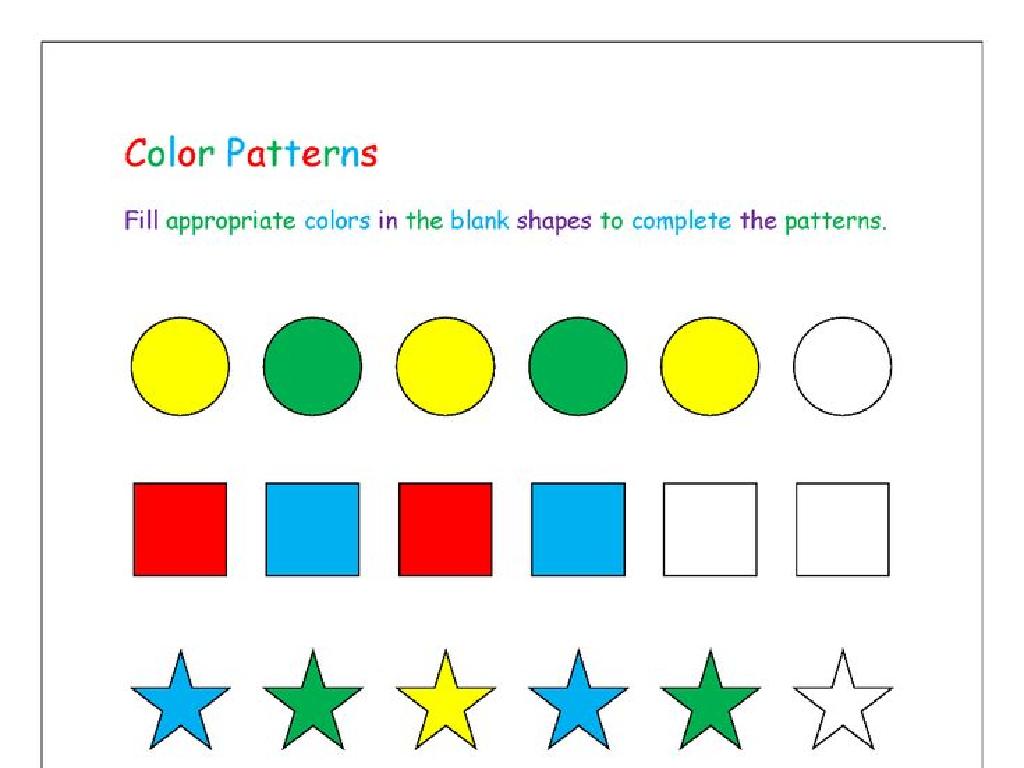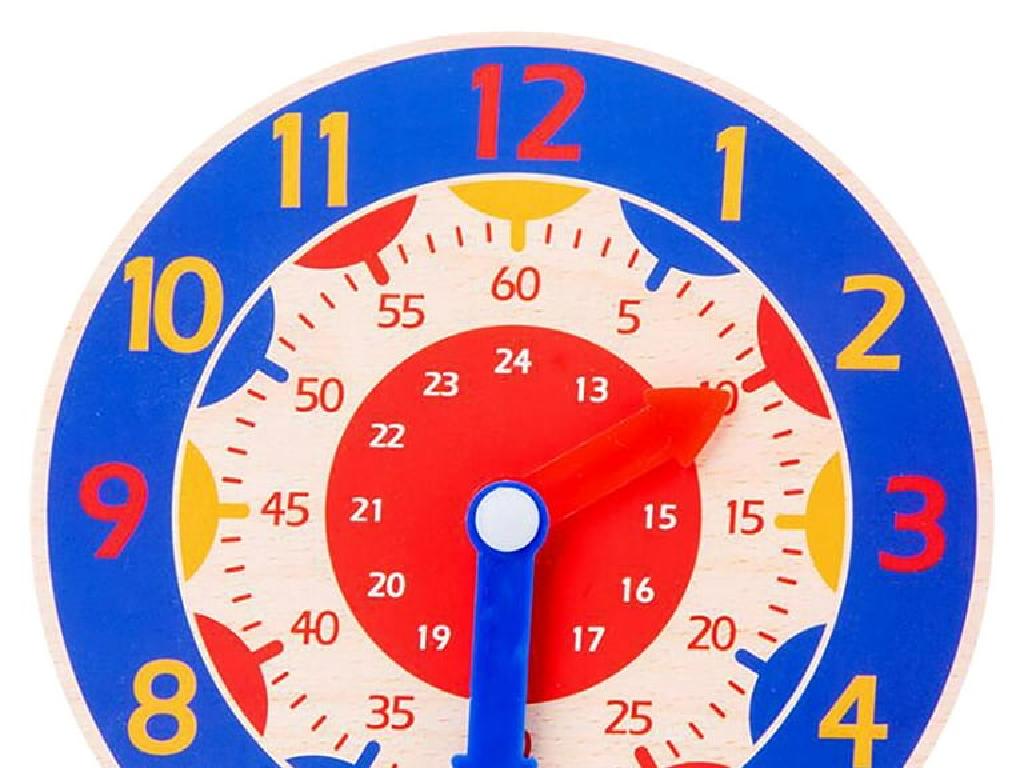Read Sight Words Set 10: Brown, Does, Eat, Must, Went
Subject: Language arts
Grade: First grade
Topic: Sight Words
Please LOG IN to download the presentation. Access is available to registered users only.
View More Content
Welcome to Sight Words!
– Learning new sight words today
– Sight words boost reading skills
– Words like ‘the’, ‘and’, ‘it’ don’t need sounding out
– Practice makes perfect
– We’ll repeat and use them in sentences
– We’ll learn together as a team
– Help each other and have fun learning
|
This slide is designed to introduce first graders to a new set of sight words: brown, does, eat, must, went. Sight words are common words that readers should recognize instantly without having to sound them out. The ability to recognize these words quickly is crucial as it helps to build reading fluency and comprehension. During the lesson, engage the students with repetitive practice and use of the words in sentences. Encourage them to help each other and create a fun learning environment. Activities can include flashcard practice, writing the words in creative ways (like with crayons or in sand), and using the words to build simple sentences. The goal is to make the students comfortable with these words by the end of the lesson.
Sight Words Set 10: Learning to Read with Ease
– What are sight words?
– Common words found often in books
– Sight words can be tricky
– They don’t always sound like they look
– Memorization helps reading
– Knowing them helps us read faster and better
– Practice makes perfect
|
This slide introduces sight words to first graders, emphasizing their importance in reading fluency. Sight words are common words that appear frequently in text but may not follow standard phonetic rules, making them challenging for early readers. By memorizing sight words, students can recognize them quickly without needing to decode them each time, leading to smoother and more confident reading. Encourage students to practice sight words regularly, using repetition and engaging activities to reinforce their memory. Provide examples of sight words from Set 10: ‘brown,’ ‘does,’ ‘eat,’ ‘must,’ ‘went,’ and discuss strategies for memorization, such as flashcards, word walls, and reading practice.
Our New Sight Words Set 10
– brown: a yummy chocolate color
– ‘The bear is brown.’
– does: ‘do’ for he, she, it
– ‘She does her homework.’
– eat: what we do when hungry
– ‘I eat an apple for snack.’
– must: something important to do
– ‘You must brush your teeth.’
– went: past of ‘go’
– ‘He went to the park yesterday.’
|
This slide introduces five new sight words to the first graders, aiming to expand their vocabulary and reading skills. ‘Brown’ is a familiar color, often associated with chocolate, which can help students remember the word. ‘Does’ is a form of the verb ‘do’ used with singular subjects, which can be a bit tricky, so provide clear examples. ‘Eat’ is a common verb that children are likely familiar with, and using it in a sentence will help solidify its meaning. ‘Must’ indicates necessity and is often used in classroom rules, making it a relevant addition. ‘Went’ is the past tense of ‘go’ and is commonly used to talk about past events. Encourage students to use these words in sentences and to look for them in their reading. During the next class, review these words and ask students to use them in their own sentences to ensure retention and understanding.
Let’s Practice ‘brown’
– Think of brown objects
– Chocolate, bear, or tree bark
– Say ‘brown’ aloud together
– Practice the pronunciation as a class
– Write ‘brown’ on whiteboards
– Use markers to write the word neatly
|
This slide is focused on the sight word ‘brown’. Start by engaging the students’ imagination and ask them to think of objects that are brown, which helps them connect the word to familiar items. Then, as a class, pronounce ‘brown’ together to reinforce auditory recognition. Finally, have the students write ‘brown’ on their whiteboards, allowing them to practice their writing skills. This multi-sensory approach helps with memorization. For the next class, prepare to review the word and possibly use it in a sentence to further solidify their understanding.
Practicing the Sight Word: ‘does’
– Understanding ‘does’ in a question
– Use ‘does’ when asking about actions. Example: What does the cat do?
– Pronouncing ‘does’ together
– Repeat after me: ‘does’, ensuring everyone says it clearly.
– Writing ‘does’ on whiteboards
– Practice writing ‘does’ neatly and correctly.
|
This slide is focused on the sight word ‘does’. Start by explaining the use of ‘does’ in a question form, which helps in understanding its application in sentences. Engage the class by asking them to repeat the word ‘does’ after you to practice pronunciation. Then, have the students write the word ‘does’ on their whiteboards, which will help in memorizing the spelling and recognizing the word visually. Encourage correct pronunciation and clear handwriting. For students who struggle, provide additional examples and one-on-one assistance. This activity reinforces reading and writing skills for the sight word ‘does’.
Let’s Practice the Sight Word: ‘eat’
– Discuss your favorite food to eat
– Share with the class to make it fun
– Practice saying ‘eat’ aloud together
– Repeat after me: ‘eat’, ‘eat’, ‘eat’
– Write ‘eat’ on your whiteboards
– Practice writing the word ‘eat’ neatly
|
This slide is designed to engage first graders in practicing the sight word ‘eat’. Start by asking students about their favorite foods, which will help them connect the word to something familiar and enjoyable. Then, lead the class in saying ‘eat’ aloud several times to reinforce pronunciation. Finally, have the students write ‘eat’ on their whiteboards, providing an opportunity for them to visualize and remember the word. Encourage correct spelling and clear handwriting. This activity helps in word recognition and is a step towards building a strong vocabulary. Make sure to walk around the classroom to assist and praise students for their efforts.
Practicing the Sight Word: ‘must’
– Discuss daily ‘must-do’ activities
– Examples: We must brush our teeth, we must go to school
– Pronounce ‘must’ as a class
– Repeat after me: M-U-S-T, must!
– Write ‘must’ on whiteboards
– Practice writing the word ‘must’ neatly
– Recognize ‘must’ in sentences
|
This slide is aimed at helping first graders practice the sight word ‘must’. Start by engaging the class in a discussion about daily routines and responsibilities to contextualize the word. Then, lead the class in choral repetition of the word ‘must’ to reinforce pronunciation. Next, have the students write ‘must’ on their whiteboards, providing individual assistance as needed. Encourage them to recognize and read the word ‘must’ in different sentences you provide. This activity will help solidify their understanding and ability to identify the sight word in various contexts.
Let’s Practice ‘went’
– Discuss ‘Where did you go yesterday?’
– Share with the class to practice ‘went’
– Practice saying ‘went’ aloud
– Repeat after me: ‘went’, ‘went’, ‘went’
– Write ‘went’ on our whiteboards
– Use your markers to write ‘went’
– Remember when to use ‘went’
|
This slide is focused on the sight word ‘went’. Start by engaging students with a question about their previous day to make them think of the word in context. Then, practice pronunciation of ‘went’ as a class to reinforce auditory recognition. Next, have students write the word ‘went’ on their whiteboards, which helps with visual and muscle memory. Lastly, remind students that ‘went’ is the past tense of ‘go’, and we use it to talk about something that happened before now. For the activity, consider having students use ‘went’ in a sentence, draw a picture of where they ‘went’, or even act out a short scenario using the word.
Game Time: Sight Word Bingo!
– Receive your Bingo card
– Listen as I say the words
– Mark the words you have
– Shout ‘Bingo!’ for a full row
– Be the first to get a full row and call out to win!
|
This interactive game is designed to help first graders recognize and read sight words from set 10: brown, does, eat, must, went. Distribute the Bingo cards, each containing a selection of sight words. As the teacher calls out the words, students will mark them on their cards. This activity not only reinforces word recognition but also adds excitement to learning. Be prepared to assist students who may struggle and encourage them to participate. Have small rewards ready for winners to motivate the class. Additionally, consider rotating the words for multiple rounds to give each student a chance to win and to reinforce the sight words further.
Review and Goodbye
– Excellent work on sight words!
– Practice at home with family
– Try using flashcards with ‘brown’, ‘does’, ‘eat’, ‘must’, ‘went’
– More words next class
– We’ll read a story together!
– Think about how these words fit into sentences
|
Today’s class focused on sight words set 10, which are crucial for building reading fluency. Encourage the students to practice these words at home, possibly with the help of family members, to reinforce their learning. Use flashcards as a suggested method for practice. In the next class, prepare to introduce additional sight words and incorporate them into a story reading activity. This will help students see the words in context and understand their usage better. Remember to praise the students for their hard work today and maintain their excitement for the next class.

